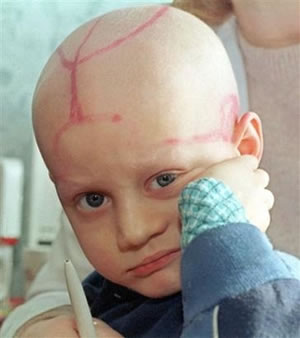|
Leukemia is a cancer of the bone marrow. The bone marrow is the spongy center of the bone which produces blood cells. With
leukemia, the white blood cells divide at abnormally high rates, but are unable to carry out the functions of normal white
blood cells. The abnormal white blood cells crowd out the healthy white blood cells and red blood cells, keeping them from
performing the functions necessary for survival.

|
| A child suffering from leukemia |
The Different Types of Leukemia
The two most common types of leukemia in children are acute lymphocytic leukemia (ALL), and acute myeloid leukemia (AML),
which is somewhat less common. The "acute" means that the disease progresses rapidly, whereas most leukemias in
adults are chronic.
For more information on distinct types of leukemia, click here
Treatment
The treatment for ALL and AML is somewhat different. For ALL, the primary treatment is chemotherapy, with radiation and bone
marrow transplantation being used in severe cases. The chemotherapy treatment begins with "induction", with the
goal of killing off all the leukemia cells located in the bone marrow. Next follows "consolidation", in which a
different combination of drugs is administered, followed by "maintenance", in which the goal is to keep the cancer
from coming back. Total treatment can last from 2-3 years.
The treatment for AML is more intense, involving aggressive chemotherapy and bone marrow transplantation when available.
AML patients do not go into maintenance chemotherapy because due to the amount of chemotherapy that their bodies have been
subjected, subsequent treatment does not help.
|



